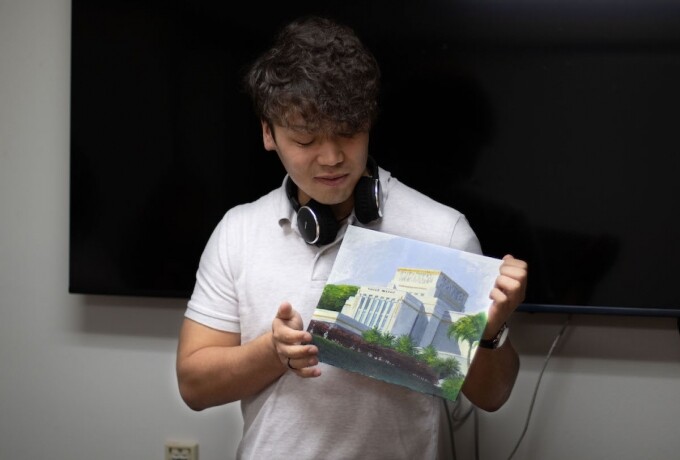
Hosted by the Office of Honor and the Student Advisory Council, students were encouraged to participate in a temple art contest to honor the temple’s centennial. The winners were chosen on Nov. 23 in the Office of Honor through online voting and a guest judge, with Micah Gallano, a sophomore from the Philippines studying elementary education, taking the spot of first place with her artwork.
Melba Latu, the dean of students at BYU–Hawaii, was in attendance when the top three students were chosen. She shared her admiration for the creativity of the students at BYUH, saying she was in awe of how the students stepped up for this competition.
There were six total submissions, and three finalists were picked at the end. Voting was open for students online through surveys and Instagram.
Latu explained how, “I don’t think there is a better way we can pay homage to the sacrifices that were made to bring us a temple.”
She talked about the effort, love and dedication the students put into their final projects. “You can’t talk about BYUH without talking about the temple … I really appreciate the love and detail I have seen in each of these works.
“I loved looking at all of these because it was such a big testimony builder to me. Seeing the care and love put into it makes it amazing.”
Regarding the competition, Latu shared, “We did it as a contest so we could get participation, but truly the rankings are arbitrary in that when we talk about the Savior, whatever we bring to him is acceptable as long as we bring it with an honest heart.”
First place: Micah Gallano
Presenting a piece of art full of color and symbolism, Gallano shared participating in this competition brought up many revelations on how unifying the temple can be in everyday life.
“One of the blessings I can see having the Laie Temple so close to BYUH is all of the nations coming in and out of the building and seeing the beautiful temple, how white it is and how it blesses us. It flows all throughout eternity, for our time right now and our future.”
With seven days of hard work, Gallano presented her unique artwork, a hand-drawn poster full of symbols, such as hands, people hugging, items of Hawaii’s past and its present.
“The main meaning of the painting is the hand of the Lord and the past and present. I believe the temple is the place where heaven and earth combine together. Our kūpuna, or our ancestors, and us performing their covenants. I put some of the cultural sides of Hawaii, including the Kalo plant and canoes.”
First runner up: Takuma Koyama
Koyama, a senior from Japan studying graphic design, came in second place with his depiction of the Laie Hawaii Temple, featuring intricate details and realistic shadows to create the feeling the temple brings to people.
He shared that initially, he was apprehensive about deciding what angle and frame he wanted to paint the temple. He said he ultimately was very satisfied with his final product.
“It’s kind of hard trying to frame the temple. I think this is very similar to how to focus on the temple and gospel in our lives … When we find Jesus Christ in our lives, we may need to take time. If we take time, we can find the good spot and frame of the temple and gospel of Jesus Christ.”
Koyama also talked about the perfect squares the temple has in its design and how it is almost too perfect to depict in art accurately. He said one of his favorite parts of the process of the painting was incorporating the bronze details on the outside of the temple.
Second runner up: Samuel Fazar
With a piece depicting the temple from an interesting angle most do not see, Fazar came in third in the competition.
While he could not attend the meeting himself, a few student representatives of his shared Fazar was trying to depict the temple from a lesser-known angle to the public. He included other details like palm trees and other greenery to create the tropical scene surrounding the temple.
His representatives also shared Fazar’s genuine understanding of the comfort, peace and holiness associated with the temple and how he believes even those who are not members can understand the sanctity of the temple and its grounds.
